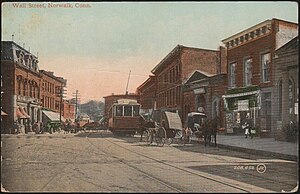
Norwalk is a city located in Western Connecticut, United States, in southern Fairfield County, on the northern shore of the Long Island Sound. Norwalk lies within both the New York metropolitan area and the Bridgeport metropolitan area.
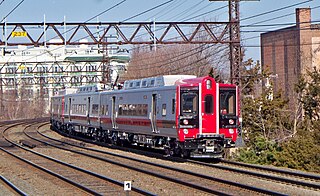
The New Haven Line is a 72.7 mi (117.0 km) commuter rail line operated by the Metro-North Railroad in the U.S. states of New York and Connecticut. Running from New Haven, Connecticut, to New York City, the New Haven Line joins the Harlem Line in Mount Vernon, New York, and continues south to Grand Central Terminal in Manhattan. The New Haven Line carries 125,000 passengers every weekday and 39 million passengers a year. The busiest intermediate station is Stamford, with 8.4 million passengers, or 21% of the line's ridership.

The Housatonic Railroad is a Class III railroad operating in southwestern New England and eastern New York. It was chartered in 1983 to operate a short section of ex-New York, New Haven and Hartford Railroad in northwestern Connecticut, and has since expanded north and south, as well as west into New York State.

The Danbury Branch is a diesel branch of the Metro-North Railroad's New Haven Line in the U.S. state of Connecticut, running from downtown Norwalk north to Danbury. It opened in 1852 as the Danbury and Norwalk Railroad. Until the early 1970s, passenger service continued north from Danbury to Canaan, Connecticut, and Pittsfield, Massachusetts. Metro-North took over operation of the line from Conrail in 1983, and the modern-day branch is mostly single-tracked.

The Danbury and Norwalk Railroad, chartered in 1835 as the Fairfield County Railroad, was an independent American railroad that operated between the cities of Danbury and Norwalk, Connecticut from 1852 until its absorption by the Housatonic Railroad in 1886. The right of way established by the D&N continues in operation and is now the Danbury Branch of the New Haven Line of the Metro-North Railroad.
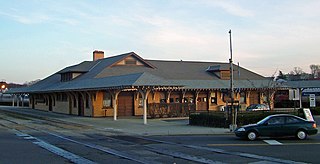
The Danbury Railway Museum is a railway museum housed in the former Union Station on the east end of downtown Danbury, Connecticut, United States. It was established in the mid-1990s following the closure of the station by the Metro-North Railroad in favor of a new station nearby, and primarily focuses on the history of railroading in southern New England and neighboring New York. In addition to the former station building, the museum has a collection of heritage railcars in the neighboring rail yard it shares with Metro-North.

Danbury station is a commuter rail station on the Danbury Branch of the Metro-North Railroad New Haven Line, located in Danbury, Connecticut. The station is the northern terminus of the Danbury Branch.

South Norwalk station is a commuter rail station in Norwalk, Connecticut, served by the Metro-North Railroad's New Haven Line. It is owned and managed by the Norwalk Transit District. The station is the point where the New Haven Line's Danbury Branch connects to the Northeast Corridor, as well as a peak-hour terminal for some express trains. Just east of the station are the South Norwalk Railroad Bridge and SoNo Switch Tower Museum.

Merritt 7 station is a commuter rail stop on the Danbury Branch of the Metro-North Railroad's New Haven Line, located in Norwalk, Connecticut. Merritt 7 is named after an adjacent business park based near the interchange of the Merritt Parkway and Route 7. The station has one high-level 6-car long side platform to the west of the single track. It is owned and operated by the Connecticut Department of Transportation (ConnDOT).

Bethel station is a commuter rail station on the Danbury Branch of the Metro-North Railroad New Haven Line, located in Bethel, Connecticut.

Redding station is a commuter rail stop on the Danbury Branch of the Metro-North Railroad New Haven Line, located in Redding, Connecticut. The station has one two-car-long high-level side platform to the west of the single track.
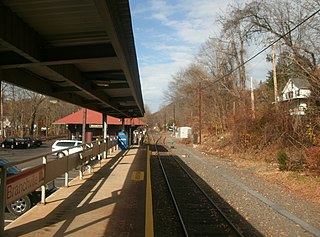
Branchville station is a commuter rail station on the Danbury Branch of the Metro-North Railroad New Haven Line, located in the Branchville neighborhood of Ridgefield, Connecticut.
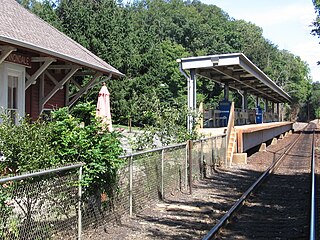
Cannondale station is a commuter rail station on the Danbury Branch of the Metro-North Railroad's New Haven Line, located in the Cannondale neighborhood of Wilton, Connecticut. The station building was added to the National Register of Historic Places in 1992 as part of the Cannondale Historic District.

Wilton station is a commuter rail station on the Danbury Branch of the Metro-North Railroad's New Haven Line, located in Wilton, Connecticut. The station first opened in 1852 and is the most used station on the Danbury Branch by weekday passengers.

East Norwalk station is a temporarily closed commuter rail station on the Metro-North Railroad New Haven Line, located in the East Norwalk neighborhood of Norwalk, Connecticut. The station building was constructed by Metro-North in the 1980s.

Cannondale is a census-designated place (CDP) within the town of Wilton in Fairfield County, Connecticut. It had a population of 141 at the 2010 census. The neighborhood consists of many old homes on large, almost rural lots now largely wooded. The English first settled the land in the 17th century. At the center of Cannondale is Cannon Crossing, a small shopping village of boutiques and restaurants made up of 19th-century buildings restored by actress June Havoc in the late 1970s on the east side of Cannondale Railroad Station. Both are part of Cannondale Historic District, which encompasses the central part of Cannondale and most of its significant historical buildings.

Brookfield station is a proposed passenger rail station on the Danbury Branch of the Metro-North Railroad New Haven Line, to be located in Brookfield, Connecticut.
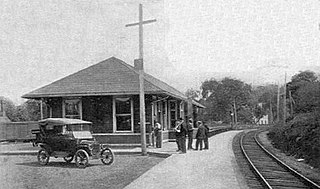
Georgetown station is a former commuter rail station on the Danbury Division of the New York, New Haven, and Hartford Railroad, located in Georgetown, Connecticut. It was in service from 1852 to 1970. A new station at Georgetown has been proposed.
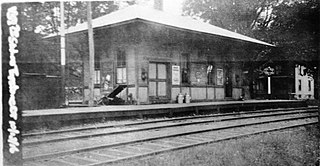
Sanford station was a passenger rail station on the Danbury and Norwalk Railroad and later the Danbury Branch of both the Housatonic Railroad and the New York, New Haven, and Hartford Railroad. The station was located on the border between Ridgefield and Redding, Connecticut, and was located on Topstone Road. Opened in 1852 as a flag stop and located in the Topstone section of Redding, Connecticut, the original station building was destroyed in 1891 by a speeding freight train. A new station building was erected the following year and would serve until the station's closure in 1938. The station was called so because of the numerous families named Sanford in the area surrounding the station.

Winnipauk was a station on the Danbury and Norwalk Railroad and later the Danbury Branch of the Housatonic Railroad and the New York, New Haven, and Hartford Railroad. Located in the Winnipauk section of the northern part of Norwalk, Connecticut, the station opened in 1852 and was an important stop that served nearby mills before it was closed in 1929.
